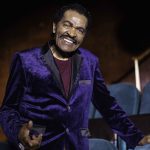Bluesman Studebaker John’s lifetime quest for performance perfection
Two of my favorite things to do are hearing great blues music and meeting cool musicians. I did both Tuesday night at Harlem Avenue Lounge in Berwyn.
Harlem Avenue Lounge is a venerable institution for live music. For more than 20 years it’s kept alive the vibe of the authentic blues joints that used to populate Chicago’s west and south sides. Proprietor Ken Zimmerman has a keen ear for talent and impeccable taste. From the full sound of electric blues bands he books on weekends to the artists he selects for Tuesday night acoustic showcases, I’ve never been disappointed at the Lounge. So when my friend Dave called and asked if I wanted to hear Studebaker John, I readily agreed. It was also a chance to meet up with friend Dennis Robling, who wanted a copy of the new CD.
The nice thing about acoustic Tuesday nights at the Lounge is the laid back nature of the proceedings. The quality of entertainment is world-class–many of the blues cats who play there have toured Europe–but usually if the crowd’s not too big you have a chance to meet the artists. Many, like John, are approachable and happy to talk about their work and music in general.
Studebaker John Grimaldi, 61, has been playing blues harmonica and guitar for about five decades. His first recording was released in 1978, and his website lists 13 albums he’s made since the early ’90s. His most recent, 2013’s “Kingsville Jukin'” by Studebaker John’s Maxwell Street Kings, was released by Delmark Records.
John’s musical influences date back to Maxwell Street, that open-air west side market where you could hear blues performed as street music. He’s a master of slide guitar and gritty harmonica playing, and creates a bass drum sound by tapping his foot on a wooden Pepsi crate that has a guitar pickup affixed to the inside. He played the entire night in open E tuning.
He also possesses a soulful voice and keen songwriting skills. John writes about Maxwell Street and all sorts of topics but avoids lyrical cliches. His writing clearly comes from the heart and draws upon personal experience.
We chatted for maybe 20 minutes, and while I wasn’t taking notes I was listening closely. He talked about the recording process, and how nowadays most studio recordings start with a click track, proceed to a guitar and vocal, then other tracks are layered on as warranted: bass, drums, keyboards, etc.
You miss the live feel of a band as a unit that way, he said. That’s not necessarily a new criticism made by fans of the analog process. But then John mentioned how the digital process enables too many artists to fix mistakes made during a recording. You know, there might be a good take with a couple bad notes, and today’s engineers can airbrush those flaws right out.
“Where’s the quest for perfection?” John asked.
That, my friends, is our thought for the week. Because John wasn’t the talent he is today when he first picked up a harmonica at age 7. He got here over a half century of always striving to be better in his live performance. An artist who works that hard to perfect his live performance is going to be able to capture that authentic live sound when he’s in the studio, and you can hear that clearly on the excellent “Kingsville Jukin’.”
Ted Slowik is a recovering blues bassist and journalist who now works in public relations. Visit TedSlowikMusic.com to learn more.




